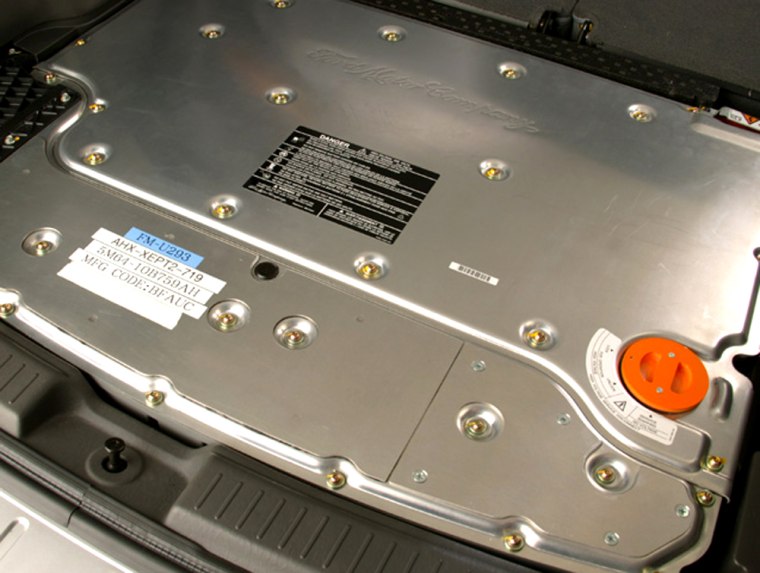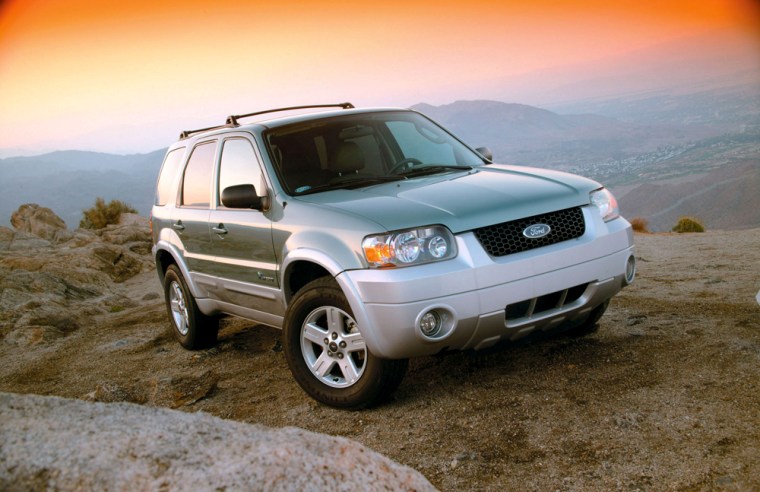The vehicle Americans both love and hate — the sport utility — is getting greener.
By summer’s end, Ford Motor Co. will launch the 2005 Escape Hybrid, the first SUV powered by a gasoline-electric hybrid powerplant.
Starting manufacturer’s suggested retail price, including destination charge, of $26,970 for a two-wheel-drive model with continuously variable transmission makes this the top-of-the-line Escape compact SUV.
Indeed, the starting price is $7,115 more than a base, two-wheel-drive Escape with four-cylinder gas engine and manual transmission.
Nonetheless, Ford officials predict strong demand because this five-passenger hybrid generates virtually no smog-producing emissions, has the acceleration of a V6 but is much more fuel efficient, and still provides versatile cargo hauling, towing and off-road capability.
In addition, the Escape is the first hybrid vehicle on the market from a U.S.-based automaker.
Current gas-electric hybrids are all cars from Japan-based automakers — the Toyota Prius five-door hatchback, Honda Civic sedan and Honda Insight two-seater.
The Escape “is the most fuel-efficient SUV in the world,” declared Jim Padilla, chief operating officer at Ford.
Counting the miles
But don’t look for the 50- or 60-mile-per-gallon government fuel economy ratings that the smaller, lighter-weight Toyota and Honda hybrids have.
While declining to give final fuel economy numbers for the Escape Hybrid just yet, Ford officials have talked generally about the vehicle “getting up to 35 mpg” in city driving and as much as 40 mpg on the highway.
This would be better than the 19 and 25 mpg, respectively, for a four-cylinder-powered, gas-only Escape with automatic transmission, and the 18 and 23 mpg, respectively, for a gas-only, V6-powered Escape with automatic.
In my test Escape Hybrid — a four-wheel-drive model that topped out at more than $32,000 with options — I managed, with a lot of slow driving, coasting and general nerve-racking, traffic-dodging maneuvers on flat streets, to eke out 40 mpg in city traffic.

On the other hand, when I took the vehicle off-road on a pretty rigorous, hilly dirt trail, I got just 13.1 mpg.
The Escape Hybrid uses a revised version of Ford’s 2.3-liter Duratec four-cylinder engine and pairs it with a 70-kilowatt, permanent magnet, AC synchronous electric motor.
The only transmission is a continuously variable unit that the driver operates like an automatic, and there’s a 330-volt nickel-metal hydride battery pack that stores excess energy for use later and powers the electric system.
'Bump' feel and sound
The hybrid SUV drives like a normal vehicle, with the engine controls deciding when the vehicle should be using electric power, or gas power, or both. All a driver does is drive.
But he or she can feel and hear, at times, the vehicle’s workings. For example, at slow speeds, there was a slight “bump” feel and sound as the Escape gas engine kicked in to add to the electric power in the test vehicle. An engineer explained that the sensation comes because the gas power has to join the electric power that already has the wheels moving.
The four-cylinder engine also can get noisy in aggressive highway driving, and on occasion, I heard unexpected sounds that I learned had to do with a fan that helps keep the proper temperature for the nickel-metal hydride battery pack at the back of the vehicle.
The Escape Hybrid’s gas engine can produce a maximum 133 horsepower and 129 foot-pounds of torque at 4,500 rpm, while the electric motor has maximum 94 horses and instantaneous torque from startup.
Better acceleration
The result is a maximum combined hybrid horsepower of 155, compared to the 153 horses in a regular four-cylinder Escape, and the 200 horsepower in a V6-powered Escape.
But the real change is in acceleration, where the Escape Hybrid can zip forward quite responsively. Indeed, Ford officials said acceleration is more like that of the V6-powered model.
On the outside of the SUV, there’s little to show this is a different kind of Escape. The only obvious signs are the badging, unique wheels and the subtle battery pack vent that’s in the glass window at the side of the rear cargo area.
Inside the Escape Hybrid, the display screen in the middle of the dashboard draws immediate attention. Its graphics display and constant fuel economy calculations aren’t as flashy as those in the Prius but serve to remind riders that stretching every bit of gas is a key benefit.
Fuel display a costly option
Note, though, this display is paired with a navigation system, operates only when the radio is on and is a $1,850 option. In the hybrid cars on the market, fuel-economy and energy-flow graphic displays, sans nav system, are standard equipment.
In the Escape, there’s also a standard battery monitor in the instrument panel and a special part of the tachometer that indicates when this Escape is in “green mode,” or operating via electric power only. The Escape Hybrid can travel up to 25 miles an hour solely using the electric motor.
At the back of the vehicle, there’s a bit less cargo room because of the need to fit the vehicle’s electric battery pack, composed of 250 D-sized cells in a sealed unit, under the cargo floor.
So, while a regular Escape offers 29.3 cubic feet of storage space behind the rear seats and maximum 66.3 cubic feet if the rear seats aren’t used by passengers, the corresponding numbers in the hybrid are 27.6 and 65.5 cubic feet, respectively.
The hybrid’s fuel tank also is smaller — 15-gallon capacity vs. 16.5 in a gas-only Escape.
Less towing capacity
And towing capacity is reduced to 1,000 pounds vs. 1,500 pounds in a four-cylinder-powered Escape and 3,500-pounds in a V6-powered model.
The Escape Hybrid has the same three-year/36,000-mile bumper-to-bumper warranty that other Escapes have. But hybrid-specific parts such as the battery pack are covered by a 100,000-mile/eight-year warranty.
Ford officials look for 20,000 hybrid sales in the coming year, with production constrained initially by battery availability.
In calendar 2003, Ford sold 167,678 Escapes. Its sibling vehicle, produced on the same assembly line, is the Mazda Tribute.
Ford has announced a Mercury version of the Escape, to be called the Mariner.
While there’s no announcement of a hybrid version of the Tribute, Ford officials have said there will be a 2007 Mariner Hybrid.
But before then, Toyota’s Lexus luxury division will introduce the first luxury SUV, the RX 4000h, by the end of this year. It will be followed by a hybrid version of the Toyota Highlander SUV early in calendar 2005.
Marty Collins, general marketing manager at Ford, said he doesn’t expect buyers of the Escape Hybrid to be much different from buyers of the regular Escape who have a median age in their early 40s.
Non-Ford owners inquisitive
Some 60 percent of the people who have asked Ford for information on the hybrid have been men, with 35 percent of them having annual household income of $75,000 to $125,000, he said.
Some 70 percent do not own a Ford now, he added.
The 2004 Toyota Prius has a starting MSRP, including destination charge, of $20,810. The 2004 Honda Civic Hybrid starts at $20,140 as a sedan with manual transmission, and Honda’s two-seat Insight gas-electric hybrid starts at $19,670.
The gas-powered Escape is a recommended vehicle of Consumer Reports magazine and has an average reliability rating.
The National Highway Traffic Safety Administration gives the 2005 Escape four out of five stars for driver and front-passenger protection in frontal crash testing.
In side crash testing, the Escape earned five out of five stars for protection of front- and rear-seat passengers. No rollover rating was provided.
The most recent safety recall of the Escape came in April this year when nearly 322,000 SUVs from the 2001, 2002 and 2003 model years were recalled because engine control modules for the 3-liter V6 needed to be reprogrammed to prevent possible stalling.
In addition, the 2001 Escape was the subject of four other safety recalls, ranging from faulty cruise control on 1,193 vehicles to potential front safety belt problems in 132,243 SUVs.
